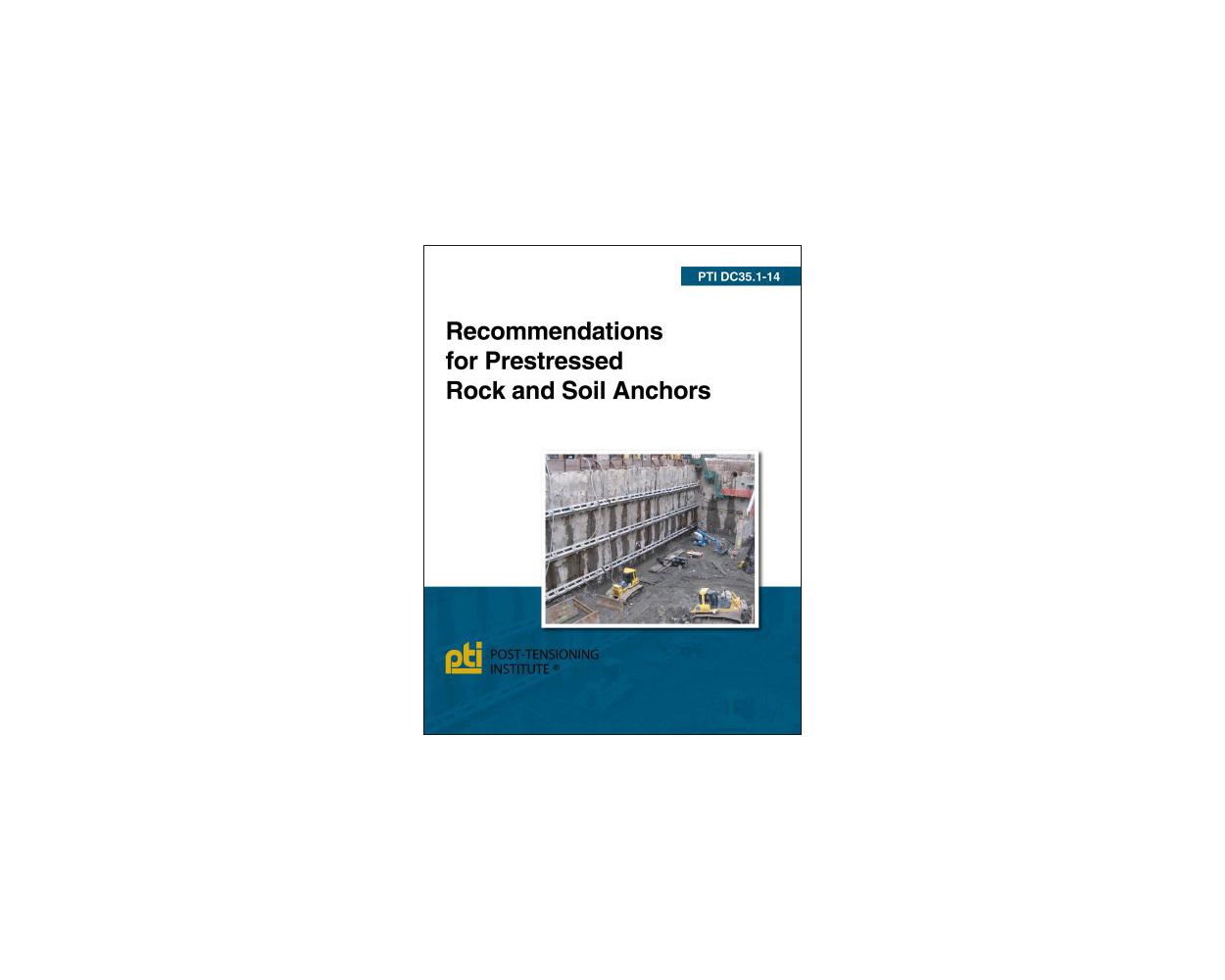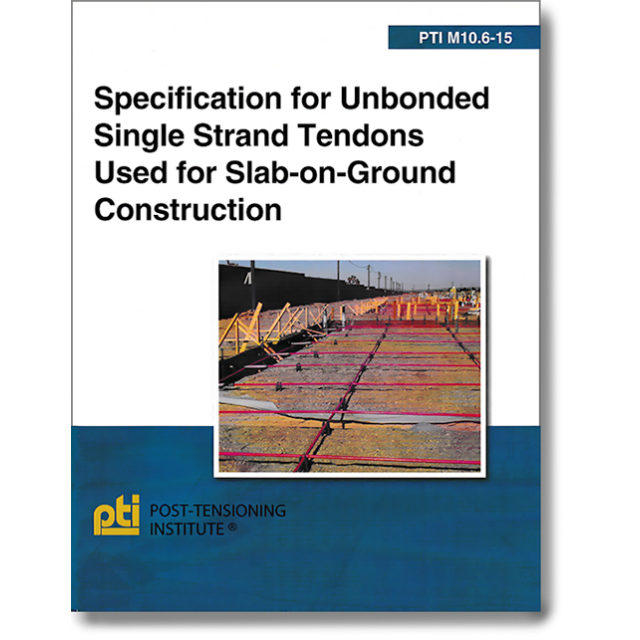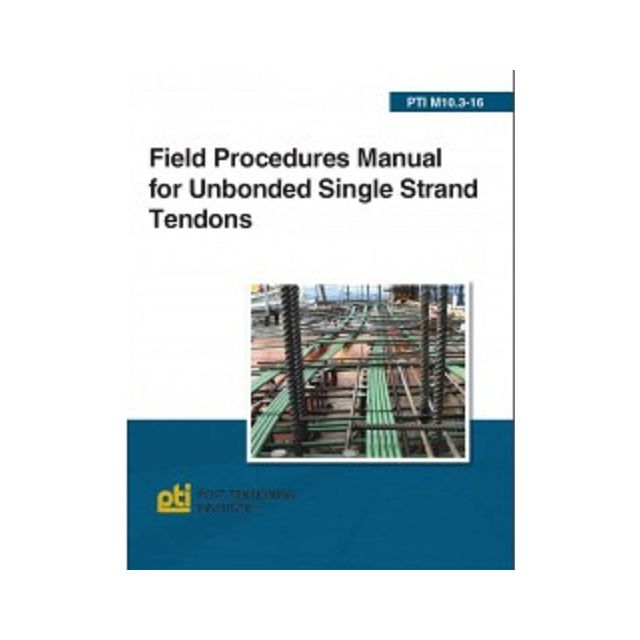PTI DC35.1-14: Recommendations for Prestressed Rock and Soil Anchors
New! PTI DC35.1-14: Recommendations for Prestressed Rock and Soil Anchors
This publication represents the current state of the art in the design and construction of permanent and temporary prestressed rock and soil anchors using high-strength prestressing steel. The recommendations provide practical guidance for the design, installation, and testing of prestressed rock and soil anchors.
These recommendations supersede the 2004 edition and include major revisions in the requirements for: • Added "Extended Temporary Anchor" category • All permanent anchors = Class I protection • Added "Special Prestressing Materials" section • Minimum tendon bond length requirements • Improved guidance for anchorage protection • Improved guidance for coupler protection • New reference to ADSC grouted wedge testing • Improved guidance for repair of corrosion protection • Additional guidance for evaluating creep movement • Improved decision tree for anchors that fail • Guidance for epoxy-coated strand has been updated, remains in supplement section.
This document was prepared by the PTI Committee for Prestressed Rock and Soil Anchors (DC-35) with input and review by the Anchored Earth Retention Committee of the International Association of Foundation Drilling.
TABLE OF CONTENTS
1.0 — Scope
2.0 — Definitions
3.0 — Specifications, Responsibilities, and Submittals
3.1 — Specifications
3.1.1 — Prescriptive specifications
3.1.2 — Performance specifications
3.1.3 — Open specifications
3.2 — Responsibilities
3.3 — Submittals
3.3.1 — General
3.3.2 — Preconstruction submittals
3.3.3 — As-built records
4.0 — Materials
4.1 — General
4.2 — Prestressing steel
4.2.1 — Strand
4.2.2 — Bar
4.2.3 — Epoxy-coated strand
4.2.4 — Epoxy-coated bar
4.2.5 — Special prestressing materials
4.2.6 — Patching materials
4.3 — Anchorages
4.4 — Couplers
4.5 — Centralizers and spacers
4.6 — Corrosion-inhibiting compounds
4.6.1 — Grease
4.6.2 — Gel
4.6.3 — Wax
4.7 — Plastic tubing
4.7.1 — Bond breaker
4.7.2 — Sheath
4.7.3 — Tendon bond length encapsulations
4.8 — Heat-shrink sleeves and tapes
4.8.1 — Heat-shrink sleeves
4.8.2 — Heat-shrink tapes
4.8.3 — Petrolatum (wax) tapes
4.8.4 — Adhesive tapes
4.9 — Grout tubes
4.10 — Grout socks
4.11 — Cement grout
4.11.1 — Cement
4.11.2 — Water
4.11.3 — Aggregates
4.11.4 — Admixtures
4.11.5 — Supplemental cementitious materials
5.0 — Corrosion protection
5.1 — Design aspects
5.2 — Corrosion protection selection criteria
5.2.1 — Service life
5.2.2 — Aggressivity of anchor environment
5.2.2.1 — Soil resistivity
5.2.2.2 — pH
5.2.2.3 — Chemical properties of soil and groundwater
5.2.2.4 — Physical properties of soil and groundwater
5.2.2.5 — Potential stray current sources
5.3 — Corrosion protection requirements
5.4 — Corrosion protection details
5.4.1 — Anchorage protection
5.4.1.1 — Anchor heads
5.4.1.2 — Bearing plates and anchor head covers
5.4.1.3 — Trumpets
5.4.2 — Free stressing length protection
5.4.2.1 — Permanently unbonded free stressing length
5.4.2.2 — Fully or partially bonded free stressing length
5.4.3 — Free stressing length/bond length transition protection
5.4.4 — Tendon bond length protection
5.4.4.1 — Class I protection
5.4.4.2 — Class II protection
5.4.5 — Protection against stray currents
5.4.6 — Coupler protection
6.0 — Design
6.1 — Introduction
6.2 — Feasibility of anchors
6.3 — Design objectives
6.4 — General considerations
6.4.1 — Corrosion protection requirements
6.4.2 — Fully bonded, partially bonded, or unbonded anchors
6.4.3 — Restressable anchor systems
6.4.4 — Destressable and removable anchor systems
6.5 — Site evaluation
6.5.1 — Rock anchors
6.5.2 — Soil anchors
6.6 — Anchor design load and safety factors
6.7 — Bond length
6.7.1 — Rock anchors
6.7.2 — Soil anchors
6.8 — Free stressing length
6.9 — Anchor geometry
6.9.1 — Anchor spacing in bond length
6.9.2 — Drill hole diameter
6.9.3 — Overburden depth
6.9.4 — Anchor inclination
6.10 — Tendon components
6.10.1 — Anchorage
6.10.2 — Encapsulation
6.10.3 — Spacers and centralizers
6.11 — Grout mixture
6.12 — Grout socks
7.0 — Construction
7.1 — General
7.2 — Fabrication
7.3 — Storage and handling
7.4 — Drilling
7.4.1 — Open hole drilling
7.4.2 — Cased holes
7.4.3 — Hollow-stem augers
7.4.4 — Combination methods
7.4.5 — Hole alignment and tolerances
7.4.6 — Hole cleaning and overdrilling
7.5 — Water pressure testing, pregrouting, and redrilling rock anchor drill holes
7.6 — Tendon repairs
7.7 — Tendon insertion
7.8 — Grouting
7.8.1 — Grouting equipment and mixing
7.8.1.1 — Neat cement grouts
7.8.1.2 — Site-mixed sanded grouts
7.8.1.3 — Ready mixed sanded grouts
7.8.2 — QA/QC for mixed grout
7.8.2.1 — Preproduction lab tests
7.8.2.2 — Preproduction field tests
7.8.2.3 — Routine QA/QC during production
7.8.2.4 — Test methods for cement-based grouts
7.8.3 — Grouting operations
7.8.3.1 — Grouting uncased holes
7.8.3.2 — Grouting cased or hollow-stem auger holes
7.8.3.3 — Grouting encapsulated tendons
7.8.3.4 — Grouting very permeable ground
7.8.3.5 — Temperature considerations
7.8.4 — Post-grouting
7.9 — Installation of anchorage
8.0 — Stressing, load testing, and acceptance
8.1 — General
8.1.1 — Preparation prior to stressing
8.2 — Equipment
8.2.1 — Requirements for equipment
8.2.2 — Equipment setup
8.3 — Testing
8.3.1 — Preproduction tests
8.3.2 — Performance tests
8.3.3 — Proof tests
8.3.4 — Supplementary extended creep tests
8.4 — Lock-off procedure
8.5 — Initial liftoff reading
8.6 — Acceptance criteria
8.6.1 — Creep
8.6.2 — Movement
8.6.2.1 — Residual movement
8.6.2.2 — Minimum apparent free tendon length
8.6.2.3 — Maximum apparent free tendon length
8.6.3 — Initial liftoff reading
8.7 — Procedures in the event of failure during testing
8.8 — Finishing work for permanent anchors
8.8.1 — Cutting stressing tails
8.8.2 — Corrosion protection (Class I or II)
8.9 — Monitoring service behavior
9.0 — References
9.1 — Referenced standards
9.1.1 — ASTM International
9.1.2 — American Association of State Highway and Transportation Officials (AASHTO)
9.1.3 — American Public Health Association (APHA)
9.1.4 — American Water Works Association (AWWA)
9.1.5 — American Concrete Institute (ACI)
9.1.6 — American Petroleum Institute (API)
9.1.7 — Federal Test Method Standard (FTMS)
9.1.8 — Post-Tensioning Institute (PTI)
9.2 — Cited references
Supplement A — Supplementary requirements for epoxy-coated strand tendons
SA1.0 — Scope
SA3.0 — Specifications, Responsibilities, and Submittals
SA3.3.2 — Preconstruction submittals
SA4.0 — Materials
SA4.2.3 — Epoxy-coated strand
SA4.3 — Anchorages
SA6.0 — Design
SA6.6 — Anchor design load and safety factors
SA6.8 — Free stressing length
SA7.0 — Construction
SA7.2 — Fabrication
SA7.3 — Storage and handling
SA7.7 — Tendon insertion
SA7.9 — Installation of anchorage
SA8.0 — Stressing, Load Testing, And Acceptance
SA8.1 — General
SA8.1.1 — Preparation prior to stressing
SA8.2 — Equipment
SA8.2.1 — Requirements for equipment
SA8.3 — Testing
SA8.4 — Lock-off procedure
SA8.6 — Acceptance criteria
SA8.6.1 — Creep
SA8.6.1.1 — Creep correction values
SA8.6.1.2 — Creep test options
SA8.6.1.4 — Acceptance criteria
SA8.6.2 — Movement
SA8.6.2.2 — Minimum apparent free tendon length
SA8.7 — Procedures in the event of strand slippage through wedges
SA9.0 — References
SA9.2 — Cited references
Supplement B — Requirements for polyester resin rock anchors
SB1.0 — Scope
SB1.1 — Definitions
SB1.2 — Specification, responsibilities, and submittals
SB1.3 — Materials
SB1.4 — Corrosion protection
SB1.5 — Design
SB1.6 — Installation
SB1.7 — Testing
SB1.7.1 — Performance testing
SB1.7.2 — Proof testing
Publisher: PTI/November 2014/109 pages/8.5 x 11 in. (Soft cover)/ISBN NO. 9780870319471
| Price | $169.95 |
|---|---|
| Customer Service | Customer ServiceWe're Here To Help Call us anytime during our customer service hours... Monday through Friday - 8:30 am to 4:30 pm (Pacific) Order Questions: TOLL FREE, 800-273-7375 (Outside the U.S. call 818-887-7828). Our Address: 8001 Canoga Avenue Canoga Park, CA 91304 US Phone: 800-275-2665 E-mail: sales@buildersbook.com
|
| Description | New! PTI DC35.1-14: Recommendations for Prestressed Rock and Soil Anchors This publication represents the current state of the art in the design and construction of permanent and temporary prestressed rock and soil anchors using high-strength prestressing steel. The recommendations provide practical guidance for the design, installation, and testing of prestressed rock and soil anchors. These recommendations supersede the 2004 edition and include major revisions in the requirements for: • Added "Extended Temporary Anchor" category • All permanent anchors = Class I protection • Added "Special Prestressing Materials" section • Minimum tendon bond length requirements • Improved guidance for anchorage protection • Improved guidance for coupler protection • New reference to ADSC grouted wedge testing • Improved guidance for repair of corrosion protection • Additional guidance for evaluating creep movement • Improved decision tree for anchors that fail • Guidance for epoxy-coated strand has been updated, remains in supplement section. This document was prepared by the PTI Committee for Prestressed Rock and Soil Anchors (DC-35) with input and review by the Anchored Earth Retention Committee of the International Association of Foundation Drilling. TABLE OF CONTENTS 1.0 — Scope 2.0 — Definitions 3.0 — Specifications, Responsibilities, and Submittals 3.1 — Specifications 3.1.1 — Prescriptive specifications 3.1.2 — Performance specifications 3.1.3 — Open specifications 3.2 — Responsibilities 3.3 — Submittals 3.3.1 — General 3.3.2 — Preconstruction submittals 3.3.3 — As-built records 4.0 — Materials 4.1 — General 4.2 — Prestressing steel 4.2.1 — Strand 4.2.2 — Bar 4.2.3 — Epoxy-coated strand 4.2.4 — Epoxy-coated bar 4.2.5 — Special prestressing materials 4.2.6 — Patching materials 4.3 — Anchorages 4.4 — Couplers 4.5 — Centralizers and spacers 4.6 — Corrosion-inhibiting compounds 4.6.1 — Grease 4.6.2 — Gel 4.6.3 — Wax 4.7 — Plastic tubing 4.7.1 — Bond breaker 4.7.2 — Sheath 4.7.3 — Tendon bond length encapsulations 4.8 — Heat-shrink sleeves and tapes 4.8.1 — Heat-shrink sleeves 4.8.2 — Heat-shrink tapes 4.8.3 — Petrolatum (wax) tapes 4.8.4 — Adhesive tapes 4.9 — Grout tubes 4.10 — Grout socks 4.11 — Cement grout 4.11.1 — Cement 4.11.2 — Water 4.11.3 — Aggregates 4.11.4 — Admixtures 4.11.5 — Supplemental cementitious materials 5.0 — Corrosion protection 5.1 — Design aspects 5.2 — Corrosion protection selection criteria 5.2.1 — Service life 5.2.2 — Aggressivity of anchor environment 5.2.2.1 — Soil resistivity 5.2.2.2 — pH 5.2.2.3 — Chemical properties of soil and groundwater 5.2.2.4 — Physical properties of soil and groundwater 5.2.2.5 — Potential stray current sources 5.3 — Corrosion protection requirements 5.4 — Corrosion protection details 5.4.1 — Anchorage protection 5.4.1.1 — Anchor heads 5.4.1.2 — Bearing plates and anchor head covers 5.4.1.3 — Trumpets 5.4.2 — Free stressing length protection 5.4.2.1 — Permanently unbonded free stressing length 5.4.2.2 — Fully or partially bonded free stressing length 5.4.3 — Free stressing length/bond length transition protection 5.4.4 — Tendon bond length protection 5.4.4.1 — Class I protection 5.4.4.2 — Class II protection 5.4.5 — Protection against stray currents 5.4.6 — Coupler protection 6.0 — Design 6.1 — Introduction 6.2 — Feasibility of anchors 6.3 — Design objectives 6.4 — General considerations 6.4.1 — Corrosion protection requirements 6.4.2 — Fully bonded, partially bonded, or unbonded anchors 6.4.3 — Restressable anchor systems 6.4.4 — Destressable and removable anchor systems 6.5 — Site evaluation 6.5.1 — Rock anchors 6.5.2 — Soil anchors 6.6 — Anchor design load and safety factors 6.7 — Bond length 6.7.1 — Rock anchors 6.7.2 — Soil anchors 6.8 — Free stressing length 6.9 — Anchor geometry 6.9.1 — Anchor spacing in bond length 6.9.2 — Drill hole diameter 6.9.3 — Overburden depth 6.9.4 — Anchor inclination 6.10 — Tendon components 6.10.1 — Anchorage 6.10.2 — Encapsulation 6.10.3 — Spacers and centralizers 6.11 — Grout mixture 6.12 — Grout socks 7.0 — Construction 7.1 — General 7.2 — Fabrication 7.3 — Storage and handling 7.4 — Drilling 7.4.1 — Open hole drilling 7.4.2 — Cased holes 7.4.3 — Hollow-stem augers 7.4.4 — Combination methods 7.4.5 — Hole alignment and tolerances 7.4.6 — Hole cleaning and overdrilling 7.5 — Water pressure testing, pregrouting, and redrilling rock anchor drill holes 7.6 — Tendon repairs 7.7 — Tendon insertion 7.8 — Grouting 7.8.1 — Grouting equipment and mixing 7.8.1.1 — Neat cement grouts 7.8.1.2 — Site-mixed sanded grouts 7.8.1.3 — Ready mixed sanded grouts 7.8.2 — QA/QC for mixed grout 7.8.2.1 — Preproduction lab tests 7.8.2.2 — Preproduction field tests 7.8.2.3 — Routine QA/QC during production 7.8.2.4 — Test methods for cement-based grouts 7.8.3 — Grouting operations 7.8.3.1 — Grouting uncased holes 7.8.3.2 — Grouting cased or hollow-stem auger holes 7.8.3.3 — Grouting encapsulated tendons 7.8.3.4 — Grouting very permeable ground 7.8.3.5 — Temperature considerations 7.8.4 — Post-grouting 7.9 — Installation of anchorage 8.0 — Stressing, load testing, and acceptance 8.1 — General 8.1.1 — Preparation prior to stressing 8.2 — Equipment 8.2.1 — Requirements for equipment 8.2.2 — Equipment setup 8.3 — Testing 8.3.1 — Preproduction tests 8.3.2 — Performance tests 8.3.3 — Proof tests 8.3.4 — Supplementary extended creep tests 8.4 — Lock-off procedure 8.5 — Initial liftoff reading 8.6 — Acceptance criteria 8.6.1 — Creep 8.6.2 — Movement 8.6.2.1 — Residual movement 8.6.2.2 — Minimum apparent free tendon length 8.6.2.3 — Maximum apparent free tendon length 8.6.3 — Initial liftoff reading 8.7 — Procedures in the event of failure during testing 8.8 — Finishing work for permanent anchors 8.8.1 — Cutting stressing tails 8.8.2 — Corrosion protection (Class I or II) 8.9 — Monitoring service behavior 9.0 — References 9.1 — Referenced standards 9.1.1 — ASTM International 9.1.2 — American Association of State Highway and Transportation Officials (AASHTO) 9.1.3 — American Public Health Association (APHA) 9.1.4 — American Water Works Association (AWWA) 9.1.5 — American Concrete Institute (ACI) 9.1.6 — American Petroleum Institute (API) 9.1.7 — Federal Test Method Standard (FTMS) 9.1.8 — Post-Tensioning Institute (PTI) 9.2 — Cited references Supplement A — Supplementary requirements for epoxy-coated strand tendons SA1.0 — Scope SA3.0 — Specifications, Responsibilities, and Submittals SA3.3.2 — Preconstruction submittals SA4.0 — Materials SA4.2.3 — Epoxy-coated strand SA4.3 — Anchorages SA6.0 — Design SA6.6 — Anchor design load and safety factors SA6.8 — Free stressing length SA7.0 — Construction SA7.2 — Fabrication SA7.3 — Storage and handling SA7.7 — Tendon insertion SA7.9 — Installation of anchorage SA8.0 — Stressing, Load Testing, And Acceptance SA8.1 — General SA8.1.1 — Preparation prior to stressing SA8.2 — Equipment SA8.2.1 — Requirements for equipment SA8.3 — Testing SA8.4 — Lock-off procedure SA8.6 — Acceptance criteria SA8.6.1 — Creep SA8.6.1.1 — Creep correction values SA8.6.1.2 — Creep test options SA8.6.1.4 — Acceptance criteria SA8.6.2 — Movement SA8.6.2.2 — Minimum apparent free tendon length SA8.7 — Procedures in the event of strand slippage through wedges SA9.0 — References SA9.2 — Cited references
Supplement B — Requirements for polyester resin rock anchors SB1.0 — Scope SB1.1 — Definitions SB1.2 — Specification, responsibilities, and submittals SB1.3 — Materials SB1.4 — Corrosion protection SB1.5 — Design SB1.6 — Installation SB1.7 — Testing SB1.7.1 — Performance testing SB1.7.2 — Proof testing Publisher: PTI/November 2014/109 pages/8.5 x 11 in. (Soft cover)/ISBN NO. 9780870319471
|






